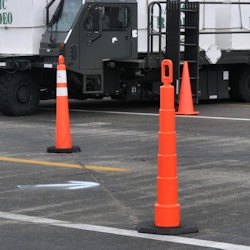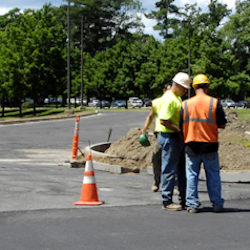Channelizing Devices
Traffic safety cones are the most common devices used to channelize traffic, divide opposing traffic lanes, divide traffic lanes when two or more lanes are kept open in the same direction, and delineate short-duration maintenance and utility work.
The minimum cone size is 18 inches tall. For speeds of 45 mph or higher, or during nighttime operations, cones must be a minimum of 28 inches tall, and have retroreflective bands.
Tubular markers having a uniform diameter and at any height, should only be used where space restrictions do not allow for other more dominate devices. Tubular markers may be used to divide opposing traffic lanes, divide open lanes in the same direction on low speed roads and to delineate the edge of a pavement drop off.
Tall Channelizing devices are a minimum of 42 inches tall, using a tapered cone type shape and are a good option for use on high speed roadways in lieu of 28 inch cones due to their greater visibility.
Traffic safety drums are 36 inches tall and are the most dominant and preferred device for multi-lane high volume highways because they have the greatest visibility.
Vertical flat panel devices and devices with directional stripe patterns are not allowed due to frequency of placement errors.
Traffic Safety Drums or Tall Channelization Devices should be used for lane closure tapers on multi-lane highways with posted speeds of 45 mph or greater. If Tall Channelization Devices are used, using half the maximum spacing to increase the taper visibility is required. Traffic Engineer approval is required to use cones for this condition.
Knowledge Check Choose the best answer for the question.
3-5. Which of the following would be the best choice for use on multi-lane highways?
You forgot to answer the question!



